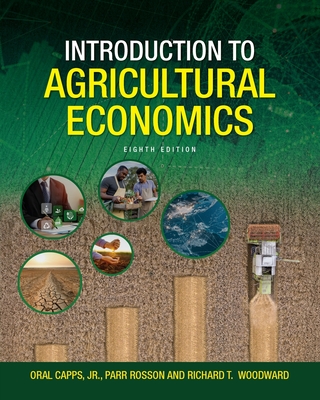Introduction to Agricultural Economics

Introduction to Agricultural Economics
The robustly updated eighth edition of the seminal textbook Introduction to Agricultural Economics provides students with a systematic overview to the fundamental economic concepts and issues within the U.S. food and fiber industry. The authors cover various aspects of both microeconomics and macroeconomics affecting the decisions of key industry participants ranging from producers to consumers.
The comprehensive text is structured around seven main areas: the scope of agricultural economics, consumer and business behaviors, market dynamics, the role of government, the economics of natural resources, macroeconomic linkages to agriculture, and international trade. Within these sections, the book explores how economic principles employed by agricultural economists can aid in understanding, predicting, and assessing the impact of economic behavior on societal well-being.
Key Updates to the Eighth Edition:
- Contains added coverage of natural resource issues, particularly repercussions of climate change on agriculture.
- Reflects the most currently available data throughout, including in all tables and figures.
- Features an extensive revision of key macroeconomic topics and how macroeconomic events affect agriculture.
This book is ideally suited for undergraduate courses in agricultural economics, providing a framework for students to think for themselves with respect to economic issues.
PRP: 1510.86 Lei
Acesta este Prețul Recomandat de Producător. Prețul de vânzare al produsului este afișat mai jos.
1359.77Lei
1359.77Lei
1510.86 LeiLivrare in 2-4 saptamani
Descrierea produsului
The robustly updated eighth edition of the seminal textbook Introduction to Agricultural Economics provides students with a systematic overview to the fundamental economic concepts and issues within the U.S. food and fiber industry. The authors cover various aspects of both microeconomics and macroeconomics affecting the decisions of key industry participants ranging from producers to consumers.
The comprehensive text is structured around seven main areas: the scope of agricultural economics, consumer and business behaviors, market dynamics, the role of government, the economics of natural resources, macroeconomic linkages to agriculture, and international trade. Within these sections, the book explores how economic principles employed by agricultural economists can aid in understanding, predicting, and assessing the impact of economic behavior on societal well-being.
Key Updates to the Eighth Edition:
- Contains added coverage of natural resource issues, particularly repercussions of climate change on agriculture.
- Reflects the most currently available data throughout, including in all tables and figures.
- Features an extensive revision of key macroeconomic topics and how macroeconomic events affect agriculture.
This book is ideally suited for undergraduate courses in agricultural economics, providing a framework for students to think for themselves with respect to economic issues.
Detaliile produsului










